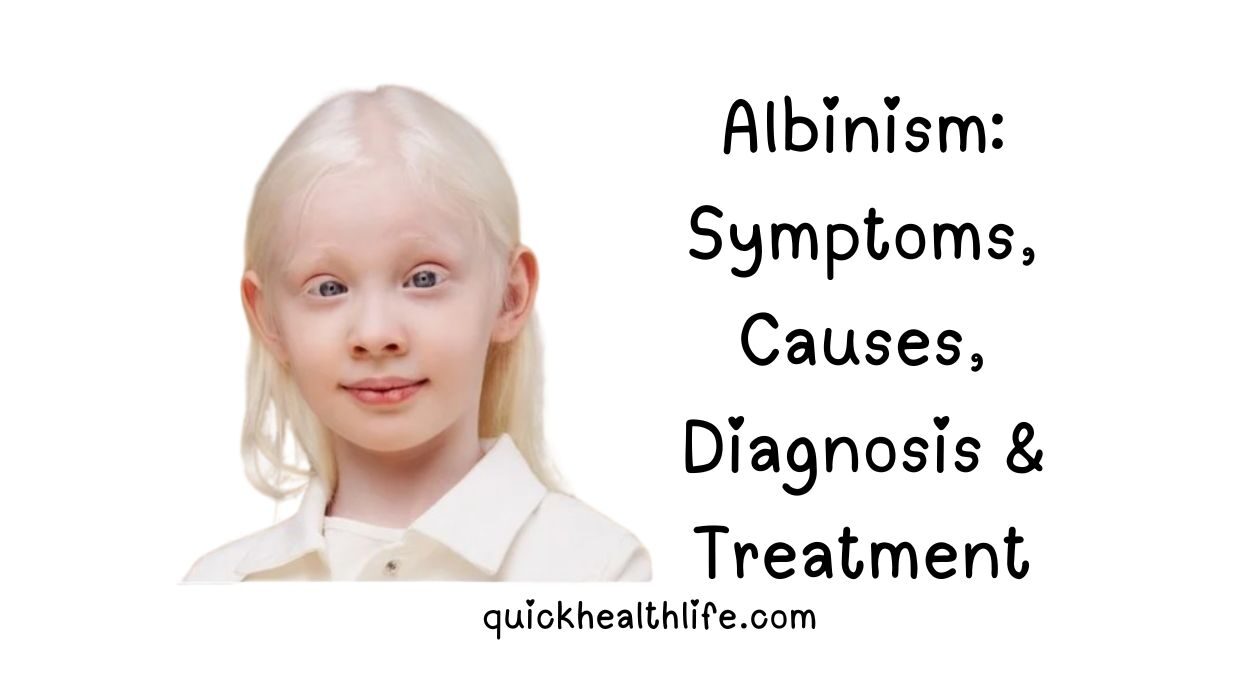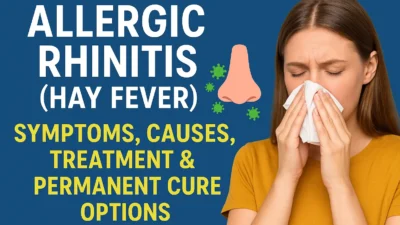What is Albinism?
Albinism is a rare genetic condition characterized by reduced or absent melanin production. Melanin is the pigment responsible for coloring our skin, hair, and eyes. This condition affects people worldwide, regardless of ethnicity or gender. While often visible through lighter physical features, albinism primarily impacts vision health and requires careful management to prevent complications.
Table of Contents
Symptoms and Characteristics
Physical Features
- Skin: Very light skin tone that burns easily in the sun
- Hair: White, blonde, or light brown hair
- Eyes: Light blue, gray, or sometimes reddish-purple appearance
Vision Problems
Vision issues are the most significant challenge for people with albinism:
- Sensitivity to light (photophobia)
- Rapid, involuntary eye movements (nystagmus)
- Crossed or misaligned eyes (strabismus)
- Reduced visual acuity
- Depth perception challenges
7 Types of Albinism
Researchers have identified multiple categories of albinism, each with unique genetic markers and clinical manifestations. Below are the 7 types of albinism most commonly recognized:
- Oculocutaneous Albinism (OCA1): Caused by mutations in the TYR gene, leading to absent or reduced tyrosinase enzyme activity.
- Oculocutaneous Albinism (OCA2): Linked to mutations in the OCA2 gene, common in sub-Saharan Africa.
- Oculocutaneous Albinism (OCA3): Caused by TYRP1 gene mutations, often seen in darker-skinned populations.
- Oculocutaneous Albinism (OCA4): Involves the SLC45A2 gene, more prevalent in East Asia.
- Oculocutaneous Albinism (OCA5–7): Rare subtypes identified through modern genetic mapping, each linked to unique genetic mutations.
- Ocular Albinism (OA1): Primarily affects the eyes with minimal impact on skin or hair pigmentation. It results from mutations on the X chromosome.
- Hermansky-Pudlak Syndrome (HPS): A syndromic form of albinism that also affects platelet function, leading to bleeding disorders and sometimes lung or bowel disease.
What Causes Albinism?
The root of albinism lies in genetics. What causes albinism is the disruption of melanin synthesis due to defective or absent enzymes. Mutations in genes responsible for producing or distributing melanin interrupt the pathway, leaving the skin, hair, and eyes underpigmented.
Genetic Basis
- Tyrosinase (TYR gene): Essential for melanin production. Defects here can lead to complete lack of pigment.
- OCA2 gene: Involved in transporting tyrosine, a precursor of melanin.
- Other related genes (SLC45A2, TYRP1, etc.): Control steps in pigment synthesis and distribution.
How is Albinism Inherited?
Understanding how is albinism inherited requires exploring genetic transmission patterns. Albinism is typically inherited in an autosomal recessive manner. This means both parents must carry one defective gene copy for their child to be affected.
Inheritance Patterns
- Autosomal Recessive Albinism: Both parents are carriers; child has a 25% chance of developing albinism.
- X-Linked Ocular Albinism: Passed through the X chromosome. Primarily affects males, while females can be carriers with minimal symptoms.
Genetic counseling plays an essential role for families with a history of albinism to understand potential risks for offspring.
Diagnosis and Management
Diagnosis
- Physical examination of skin, hair, and eye coloring
- Comprehensive eye exam
- Genetic testing to identify specific gene mutations
Vision Management
- Prescription glasses or contact lenses
- Low-vision aids and devices
- Vision therapy and exercises
- Surgery for strabismus in some cases
Skin Protection
- High-SPF sunscreen (SPF 30+)
- Protective clothing and wide-brimmed hats
- UV-blocking sunglasses
- Regular skin checks for sun damage
Albinism Treatment
Currently, there is no cure that can restore melanin production. However, albinism treatment focuses on managing symptoms and reducing complications.
Eye Care
- Prescription glasses or contact lenses to improve visual clarity.
- Low-vision aids such as magnifiers.
- Surgical correction for strabismus.
Skin Care
- Regular use of high-SPF sunscreen.
- Protective clothing, hats, and sunglasses to shield from UV damage.
- Routine dermatological examinations to monitor for sun-induced skin conditions.
Lifestyle & Support
- Genetic counseling for affected families.
- Educational accommodations such as large-print materials or digital aids.
- Psychosocial support to help individuals overcome stigma or discrimination.
Complications Associated with Albinism
Although albinism does not inherently shorten lifespan, individuals may face health risks:
- Skin Cancer: Due to prolonged UV exposure.
- Vision Impairments: Persistent, often non-correctable by conventional surgery.
- Social Challenges: Misconceptions and myths can lead to discrimination.
- Syndromic Complications: In conditions like Hermansky-Pudlak Syndrome, additional systemic issues arise.
FAQs on Albinism
1. Is albinism contagious?
No, albinism is purely genetic and cannot be transmitted through contact.
2. Can albinism be cured?
There is no cure, but symptom management and protective measures can significantly improve quality of life.
3. Do people with albinism always have white hair and skin?
Not always. Depending on the type, hair and skin pigmentation can vary from very light to moderately pigmented.
4. Are all forms of albinism associated with vision problems?
Yes, almost all types affect eye development and vision to some degree.
5. Can people with albinism live normal lifespans?
Yes. With proper medical care and sun protection, individuals with albinism can live full, healthy lives.



